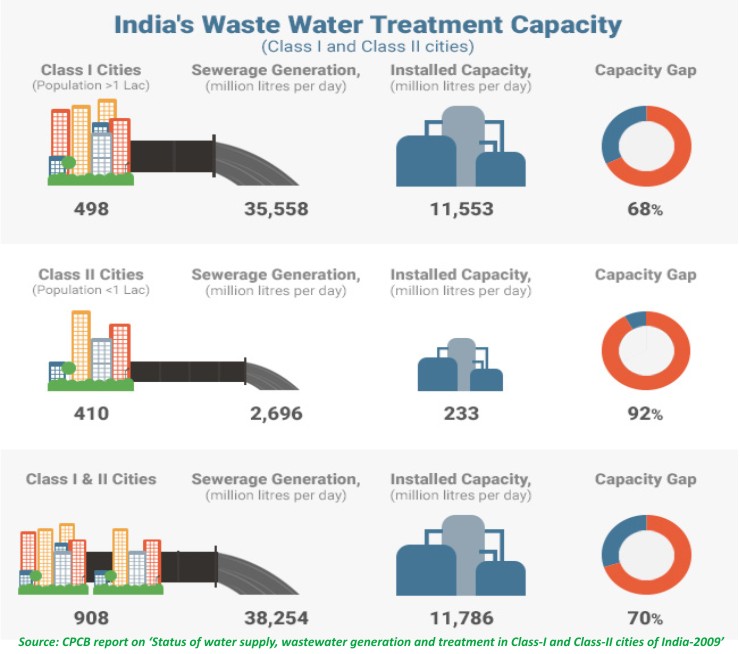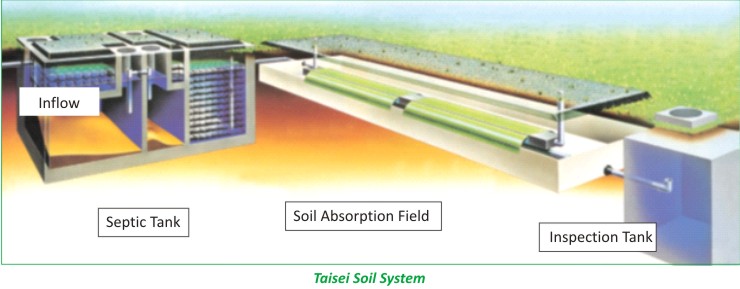|
Decentralised Wastewater Treatment in India
There is a large gap between generation and treatment of wastewater in India. According to the Swachhta status report 2016, released by the Ministry of Statistics and Programme Implementation, just 59.3% of the population and 56.4% wards in India (both rural and urban) are reported to have sewer network for disposal of wastewater. This indicates only a marginal improvement from around 50% sewer connections in the year 2011 (as per Census 2011). As per the Central Pollution Control Board (CPCB) report ‘Status of Sewage Treatment in India’, the total treatment capacity gap between the waste water generation and its treatment in Class I and Class II cities of India combined is as high as 70%. At the current rate of progress of sewer network and infrastructure development, it shall take several decades to achieve safe disposal of liquid waste in Indian cities. Even the existing treatment capacity is not effectively utilised due to operation and maintenance issues. Nearly 39% plants are not conforming to the general standards prescribed under the Environmental (Protection) Rules for discharge into streams as per the CPCB’s survey report . In a number of cities, the existing treatment capacity remains under utilised while a lot of sewage is discharged without treatment. There is a need to adopt new ways of dealing with wastewater, which are affordable and sustainable. Indian cities must adopt a hybrid approach of centralised as well as decentralised planning to bridge the gap in wastewater treatment and abate the water scarcity and rising levels of water pollution. Decentralised management of wastewater has been defined as the collection, treatment and reuse of wastewater at or near the point of generation. It is being considered as an alternative to or complement the large, centralised collection and treatment systems. A commonly used acronym for decentralised wastewater treatment system is DEWATS. For example, the majority of new development in cities occurs at the outer edge, and as cities grow larger and larger it becomes less feasible to connect these new developments with the existing sewer network. Decentralised collection and treatment systems are becoming a more common approach for suburban housing developments.
For small communities and individual households, a broad range of technologies are available for treating wastewater. At one end of the spectrum are technologies that use gravity flow, have few or no moving parts, and rely on natural processes to achieve most of the treatment. These technologies tend to be lower cost, have few or no energy requirements, and require less operation and maintenance. In an endeavour to promote nature based solutions for wastewater treatment, Technology and Action for Rural Advancement (TARA), the social enterprise wing of the Development Alternatives Group with support from Japanese International Cooperation Agency (JICA), has partnered with a Japanese company Taisei Kougyou, to validate and promote their soil based decentralised wastewater treatment technology - Taisei Soil System (TSS) in India. The objective of the project is to do the field validation of TSS to tackle the problem of wastewater treatment in a decentralised manner, to establish a business model for the pay-for-use public toilets and the formulation of dissemination plan for the technology. One of the best advantages of the TSS system is that it does not require any mechanical, electrical or chemical inputs for on-going operations. Once constructed, the system keeps running for decades with no touch operations and near zero maintenance, which is one of the most essential features for success in an Indian scenario, where due to lack of proper operation and maintenance systems, wastewater treatment technologies are more prone to failure. Other key features of the technology are as mentioned below: • It is a zero-discharge system of wastewater treatment. • The system treats the wastewater by aerobic treatment in the soil absorption field. • The system is installed underground. Consequently, the top surface area is available for plantation. The plants absorb water from the soil absorption field. • 98% or more reduction of Biological Oxygen Demand. • The system can handle large load variations hence best suitable for Indian scenario.
The pilot plant of the TSS system has been successfully running in Varanasi (4000 L/day) since June 2019 where the wastewater from a community toilet near a school is being treated by the TSS system. Another pilot plant in Muzaffarnagar (8000 L/day) is under construction and will be ready by early 2020. The agreement has been done with the Municipal Cooperation/ Municipality in both the cities, who have extended all their possible support to make the project a success including the availability of land, testing support and connection with the respective departments to propagate the technology after the validation is completed. Endnotes
Utkarsh, Neha, Pramod
|

